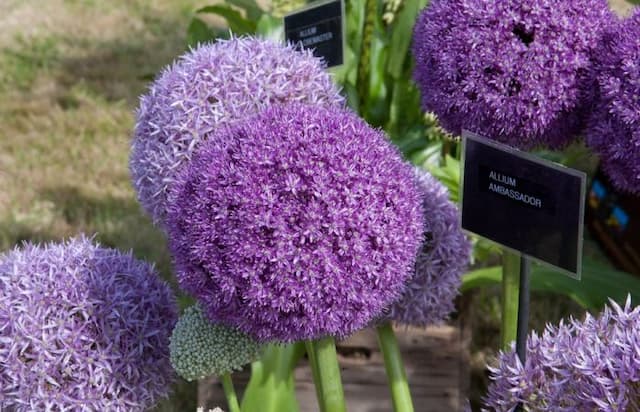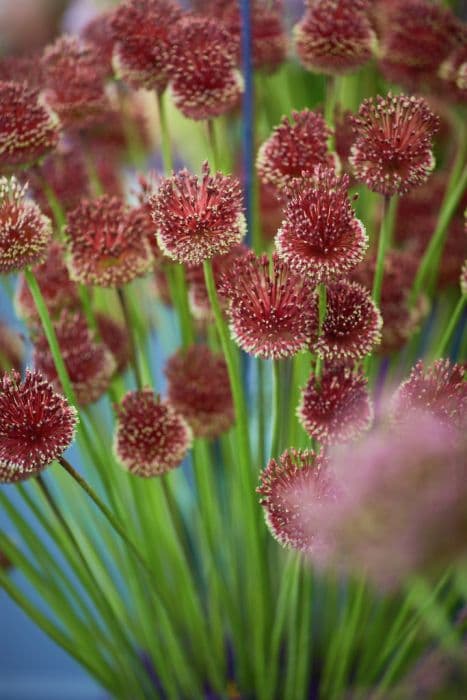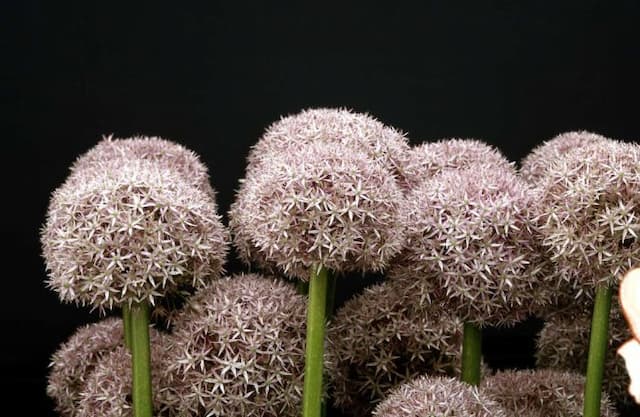Mount Everest Onion Allium stipitatum 'Mount Everest'

ABOUT
Allium stipitatum 'Mount Everest' is a striking ornamental onion that boasts large, spherical flower heads comprised of numerous star-shaped flowers. The blooms are an eye-catching white, creating a stunning contrast against the green foliage. The leaves are broad and strap-like, with a lush green appearance that forms a clump at the base of the plant. Before blooming, the buds are enclosed in a papery bract, which eventually peels back as the flowers begin to open. As an ornamental onion, it shares family traits with the well-known kitchen onions but is celebrated for its impressive floral display. The sturdy stems hold the flower heads aloft, making them a standout in any garden setting. The plant blooms in the late spring to early summer, providing a refreshing pop of brightness after the flush of early spring flowers.
About this plant
 Names
NamesFamily
Amaryllidaceae
Synonyms
Persian Shallot, Ornamental Onion
Common names
Allium stipitatum 'Mount Everest'.
 Toxicity
ToxicityTo humans
The ornamental onion is generally not considered toxic to humans. They are part of the Allium family, which also includes onions, garlic, and chives, commonly used in cooking. However, consumption of large quantities can potentially lead to gastrointestinal irritation or discomfort. Sensitivity varies from person to person, and certain individuals might experience more pronounced reactions than others. While not considered dangerous, it's advisable to avoid ingesting ornamental onion in large amounts due to the potential for digestive upset.
To pets
The ornamental onion is toxic to pets, including cats and dogs. It contains compounds that can cause oxidative damage to red blood cells, leading to a condition known as hemolytic anemia. Symptoms of poisoning in pets may include vomiting, diarrhea, weakness, decreased appetite, abdominal pain, and potentially an elevated heart rate or respiratory rate. In severe cases, ingesting ornamental onion can result in jaundice, difficulty breathing, or collapse. If a pet has ingested any part of an ornamental onion plant, it is important to seek veterinary care immediately as the consequences can be serious and potentially life-threatening.
 Characteristics
CharacteristicsLife cycle
Perennials
Foliage type
Deciduous
Color of leaves
Green
Flower color
White
Height
3-4 feet (0.9-1.2 meters)
Spread
1-2 feet (0.3-0.6 meters)
Plant type
Bulb
Hardiness zones
4
Native area
Middle East
Benefits
 General Benefits
General Benefits- Aesthetic Appeal: Allium stipitatum 'Mount Everest', commonly known as Persian Onion, adds striking visual interest to gardens with its towering stems and large, spherical white flowers.
- Attracts Pollinators: Persian Onion's blooms are attractive to bees and other pollinating insects, which are essential for the health of gardens and the pollination of other plants.
- Easy to Grow: This ornamental onion is relatively easy to cultivate and can thrive in a variety of soil conditions as long as there is good drainage.
- Drought Resistance: Once established, the Persian Onion is quite drought-tolerant, requiring minimal watering and reducing the need for irrigation.
- Pest Resistance: The scent and taste of all Allium species tend to deter many pests, making Persian Onion a good companion plant that can reduce the need for chemical pest controls.
- Long Bloom Time: Persian Onion has a long flowering period, which can last several weeks, ensuring prolonged garden interest throughout the growing season.
- Cut Flowers: The flowers of the Persian Onion make excellent cut flowers due to their height, sturdiness, and long vase life, enhancing indoor decor.
- Deer and Rodent Resistance: Unlike other garden plants, Persian Onion is generally resistant to deer and rodents, which tend to avoid alliums due to their taste and odor.
- Low Maintenance: Requiring very little care once established, Persian Onion is ideal for gardeners seeking high-impact plants with minimal upkeep.
- Multiplication: Over time, this plant can produce offsets, leading to natural clumping or spreading in the garden, which can be divided and shared.
- Seasonal Interest: The distinctive foliage and flower form of Persian Onion provide seasonal interest, starting with spring foliage and culminating in stunning late spring or early summer blooms.
- Structural Element: Due to its height and form, Persian Onion can serve as a structural element in garden design, offering vertical lines and architectural detail.
 Medical Properties
Medical Properties- Antibacterial: Allium stipitatum 'Mount Everest' may have natural antibacterial properties, particularly against some strains of bacteria.
- Antifungal: The plant might also possess antifungal effects, potentially helping to inhibit the growth of certain fungi.
- Antioxidant: Exhibits antioxidant activities, which may be beneficial in protecting the body from oxidative stress and free radicals.
 Air-purifying Qualities
Air-purifying QualitiesThis plant is not specifically known for air purifying qualities.
 Other Uses
Other Uses- Allium stipitatum 'Mount Everest', or ornamental onion, can be used in floral arrangements both fresh and dried, providing a unique, spherical shape and a touch of whimsical architecture.
- The plant can be grown as a companion plant in vegetable gardens, where its presumed repellent qualities can help protect against certain insect pests.
- The ornamental onion's tall and sturdy stems can be used as natural stakes for supporting weaker or drooping plants in the garden.
- Its attractive blossoms can be a source of nectar for pollinators like bees and butterflies, promoting biodiversity in the garden.
- Ornamental onion bulbs can be planted as a living fence or boundary marker, offering an aesthetically pleasing alternative to traditional fencing.
- Creative gardeners might use the hollow stems of ornamental onions for small, whimsical craft projects like miniature floral arrangements or natural confetti tubes for celebrations.
- These plants can be used in educational projects about plant lifecycles, bulb growth, or pollination due to their clear and observable growth stages.
- The seed heads of Allium stipitatum 'Mount Everest' can be spray-painted and used in art installations or as part of decorative displays in public spaces or events.
- Onion-scented plants like the ornamental onion can sometimes be used in sensory gardens, where touch, sight, and smell are engaged for an interactive garden experience.
- The distinct look of the ornamental onion can inspire people to create botanical illustrations and enhance their observation and artistic skills.
Interesting Facts
 Feng Shui
Feng ShuiThe Persian Onion is not used in Feng Shui practice.
 Zodiac Sign Compitability
Zodiac Sign CompitabilityThe Persian Onion is not used in astrology practice.
 Plant Symbolism
Plant Symbolism- Purity: The 'Mount Everest' allium, with its striking white blooms, is often associated with purity and innocence, similar to the symbolic meaning attributed to the color white in many flowers.
- Dignity: The tall, upright stance of the 'Mount Everest' allium represents dignity and pride, making it a symbol of self-respect and the respect one commands from others.
- Perseverance and Strength: Alliums are known for their hardiness and ability to grow in different conditions, symbolizing the ability to persevere and remain strong in the face of adversity.
- Unity: The globe-shaped flowerhead of the 'Mount Everest' allium is composed of many small flowers clustered together, symbolizing unity and the coming together of many parts to make a whole.
 Water
WaterThe Ornamental Onion or 'Mount Everest' prefers moderate watering, requiring that the soil be kept evenly moist but not waterlogged. During the growing season, water once a week with about 1 inch of water or enough to soak the soil to a depth of 6 inches. Adjust the frequency to account for rainfall and check the soil moisture to determine when to water; it may need more frequent watering in dry conditions and less when it's cooler or cloudy. During dormancy in winter, reduce watering significantly, only ensuring that the soil does not completely dry out. Overwatering and poor drainage can lead to bulb rot, so it's important to provide well-draining soil.
 Light
LightThe Ornamental Onion thrives best in full sunshine. It should be planted in a location where it can receive at least 6 to 8 hours of direct sunlight daily. If positioned in too much shade, the plant may not bloom as vigorously and the stems may become weak and floppy.
 Temperature
TemperatureThe Ornamental Onion can tolerate a wide range of temperatures but performs optimally when daytime temperatures are between 65°F to 75°F. It is hardy in USDA zones 4 through 8, surviving minimum temperatures down to -30°F. During active growth, protect the plants from extreme heat by ensuring they have plenty of water and some mulch to keep the roots cool.
 Pruning
PruningPruning is not generally required for the Ornamental Onion, but spent flower stalks can be cut back to the ground after blooming to keep the garden tidy and prevent the plant from self-seeding excessively. This maintenance can be performed once the flower heads have faded and dried, usually in late summer or early fall.
 Cleaning
CleaningAs needed
 Soil
SoilOrnamental onion 'Mount Everest' thrives in well-draining soil with a pH range of 6.0 to 7.0. A mix incorporating equal parts of loam, sand, and organic compost would provide the ideal conditions for its growth, ensuring adequate drainage and fertility.
 Repotting
RepottingOrnamental onion 'Mount Everest' typically does not require frequent repotting and can be done every 3-4 years. It's best repotted after the flowering period when the foliage starts to die back.
 Humidity & Misting
Humidity & MistingOrnamental onion 'Mount Everest' is tolerant of a range of humidity levels and does not require any specific humidity conditions. However, as a general guideline, it thrives in average outdoor humidity.
 Suitable locations
Suitable locationsIndoor
Place in bright light, provide good airflow, and water sparingly.
Outdoor
Plant in full sun, well-drained soil, and space 15-20cm apart.
Hardiness zone
4-9 USDA
 Life cycle
Life cycleAllium stipitatum 'Mount Everest', commonly known as Persian shallot or Ornamental onion, begins its life as a dormant bulb that breaks dormancy in early spring. The bulb sends up long, narrow, strap-shaped leaves as temperatures warm, followed by tall, sturdy flower stems that rise above the foliage. By late spring to early summer, the plant blooms with large, showy white umbels atop the stems which attract pollinators such as bees and butterflies. After flowering, the plant sets seed, and the foliage begins to yellow and die back as the plant enters a period of summer dormancy. The seeds, if not collected, may disperse near the parent plant, potentially giving rise to new seedlings. The bulb remains dormant underground through the winter until the next growing season.
 Propogation
PropogationPropogation time
Spring to early summer
Allium stipitatum 'Mount Everest', commonly known as Ornamental Onion, is typically propagated through bulb division. The ideal time to propagate this plant is in the fall, after the leaves have died back and the plant is entering dormancy. To propagate, carefully dig up the bulbs, ensuring not to damage them. Once removed from the ground, you'll notice that the main bulb may have produced smaller bulblets attached to its base. Gently separate these bulblets from the mother bulb. Replant these immediately at a depth of about 3 inches (approximately 7.5 centimeters) with the pointed end facing upwards, spaced about 8 inches (20 centimeters) apart to ensure adequate room for growth. Water the newly planted bulbs thoroughly to establish them. This method of propagation is simple and helps to expand your collection of Alliums or replenish older clumps that may have started to decline in vigor.









